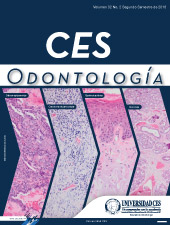Uso de aislamiento absoluto con dique de goma en tratamientos restaurativos por rehabilitadores orales en el departamento de Antioquia
DOI:
https://doi.org/10.21615/cesodon.31.2.3Palabras clave:
Aislamiento, Dique de goma, Encuesta, Rehabilitación oralResumen
Introducción y Objetivo: El aislamiento absoluto del campo operatorio condique de goma (DG), es esencial para el resultado exitoso del tratamiento endodóntico y restaurador. A la fecha, no existe evidencia científica que soporte su uso entre rehabilitadores orales. Los propósitos de este estudio fueron: determinar la frecuencia del uso de DG como método de aislamiento absoluto, identificar que variables sociodemográficas influenciaron su uso y conocer las principales razones de su uso o no por rehabilitadores orales del departamento de Antioquia durante los procedimientos restaurativos. Materiales y métodos: Una encuesta autodiligenciable con 17 preguntas fue hecha a 77 rehabilitadores orales. Un análisis estadístico descriptivo univariado y bivariado utilizando la prueba de chi cuadrado de Pearson fue utilizado para determinar la asociación entre los factores demográficos y el uso o no del DG (P <0.05). Resultados: En general, la prevalencia del uso del DG fue de 89,6% intervalo de confianza (IC) 95% (82,8%- 96,4%), siendo mayoren el sector posterior 61,1%, seguido por 55,9% en el sector anterior, 19,5% cementación de postes y 14,3% en la elaboración de postes. Mientras la falta de tiempo con 44,2% y no ver la necesidad 28,6%, fueron las razones más prevalentes para omitir el uso del DG; el control de la humedad con 81,8% y mejorar la adhesión 71,4%, justificaron su uso. La experiencia clínica fue la única variable que influenció el uso del DG (P = 0.03). Conclusión: El uso de DG fue más frecuente para el sector posterior que el anterior, y frecuentemente omitido para la elaboración y cementación de postes.
Descargas
Referencias bibliográficas
European Society of Endodontology. Quality guidelines for endodontic treatment: consensus report of the European Society of Endodontology. Int Endod J. 2006;39(12):921-930.
Ammann P, Kolb A, Lussi A, Seemann R. Influence of rubber dam on objective and subjective parameters of stress during dental treatment of children and adolescents - a randomized controlled clinical pilot study. Int J Paediatr Dent. 2013;23(2):110-115.
Cochran MA, Miller CH, Sheldrake MA. The efficacy of the rubber dam as a barrier to the spread of microorganisms during dental treatment. J Am Dent Assoc. 1989;119(1):141-144.
Samaranayake LP, Reid J, Evans D. The efficacy of rubber dam isolation in reducing atmospheric bacterial contamination. ASDC J Dent Child. 1989;56(6):442-444.
Liebenberg WH. Extending the use of rubber dam isolation: alternative procedures. Part I. Quintessence International. 1992;23(10):657-657-665.
Thorpe BL. History of Dental Surgery. Biographies of Pioneer American Dentists and Their Successors. Koch C, editor. Vol. 3. National Art Publishing Co.; 1910. 417 p.
Hitmi L, Attal JP, Degrange M. Influence of the time-point of salivary contamination on dentin shear bond strength of 3 dentin adhesive systems. J Adhes Dent. 1999;1(3):219-232.
Knight GT, Barghi N, Berry TG. Comparing two methods of moisture control in bonding to enamel: a clinical study. Oper Dent. 1991;16(4):130-135.
Stape THS, Tjäderhane L, Abuna G, Sinhoreti MAC, Martins LRM, Tezvergil-Mutluay A. Optimization of the etch-and-rinse technique: New perspectives to improve resin–dentin bonding and hybrid layer integrity by reducing residual water using dimethyl sulfoxide pretreatments. Dental Materials. 2018;34(7):967-977.
Choi A-N, Lee J-H, Son S-A, Jung K-H, Kwon YH, Park J-K. Effect of Dentin Wetness on the Bond Strength of Universal Adhesives. Materials (Basel). 2017;10(11).
Kapitán M, Sustova Z, Ivancakova R, Suchanek J. A comparison of different rubber dam systems on a dental simulator. Acta Medica (Hradec Kralove). 2014;57(1):15-20.
Lawson NC, Gilbert GH, Funkhouser E, Eleazer PD, Benjamin PL, Worley DC. General Dentists’ Use of Isolation Techniques during Root Canal Treatment: From the National Dental Practice-based Research Network. J Endod. 2015;41(8):1219-1225.
Tanalp J, Kayataş M, Can EDB, Kayahan MB, Timur T. Evaluation of senior dental students’ general attitude towards the use of rubber dam: a survey among two dental schools. ScientificWorldJournal. 2014;2014:290101.
Kapitán M, Sustová Z. The use of rubber dam among Czech dental practitioners. Acta Medica (Hradec Kralove). 2011;54(4):144-148.
Unal GC, Kaya BU, Tac AG, Kececi AD. Survey of attitudes, materials and methods preferred in root canal therapy by general dental practice in Turkey: Part 1. Eur J Dent. 2012;6(4):376-384.
Raoof M, Zeini N, Haghani J, Sadr S, Mohammadalizadeh S. Preferred materials and methods employed for endodontic treatment by Iranian general practitioners. Iran Endod J. 2015;10(2):112-116.
Soldani F, Foley J. An assessment of rubber dam usage amongst specialists in paediatric dentistry practising within the UK. Int J Paediatr Dent. 2007;17(1):50-56.
Savani GM, Sabbah W, Sedgley CM, Whitten B. Current Trends in Endodontic Treatment by General Dental Practitioners: Report of a United States National Survey. J Endod. 2014;40(5):618-624.
Fernández R, Monsalve S, Vásquez J, Robayo J, Lacouture O, Álvarez G. Rubber dam use in endodontic treatment and restorative dentistry by general dentists in a South American Sub-population. Int J Endod Rehab. 2016;2(1):29-38.
Al-Omari WM. Survey of attitudes, materials and methods employed in endodontic treatment by general dental practitioners in North Jordan. BMC Oral Health [Internet]. 2004 [citado 28 de julio de 2016];4(1). Disponible en: http://bmcoralhealth.biomedcentral.com/articles/10.1186/1472-6831-4-1
Mathias P, Rocha V, Saraiva L, Cavalcanti AN, Azevedo JF, Paulillo LAMS. Intraoral environment conditions and their influence on marginal leakage in composite resin restorations. Acta Odontol Latinoam. 2010;23(2):105-110.
Jacquot B, Durand J-C, Farge P, Valcarcel J, Deville de Périère D, Cuisinier F. Influence of temperature and relative humidity on dentin and enamel bonding: a critical review of the literature. Part 1. Laboratory studies. J Adhes Dent. 2012;14(5):433-446.
Lynch CD, McConnell RJ. Attitudes and use of rubber dam by Irish general dental practitioners. Int Endod J. 2007;40(6):427-432.
Feizbakhsh M, Aslani F, Gharizadeh N, Heidarizadeh M. Comparison of bracket bond strength to etched and unetched enamel under dry and wet conditions using Fuji Ortho LC glass-ionomer. J Dent Res Dent Clin Dent Prospects. 2017;11(1):30-35.
Whitworth JM, Seccombe GV, Shoker K, Steele JG. Use of rubber dam and irrigant selection in UK general dental practice: UK endodontic practice. Int Endod J. 2000;33(5):435-441.
Mala S, Lynch CD, Burke FM, Dummer PMH. Attitudes of final year dental students to the use of rubber dam. Int Endod J. 2009;42(7):632-638.
Zou H, Li Y, Lian X, Yan Y, Dai X, Wang G. Frequency and Influencing Factors of Rubber Dam Usage in Tianjin: A Questionnaire Survey. Int J Dent. 2016;2016:7383212.
Demarco FF, Baldissera RA, Madruga FC, Simões RC, Lund RG, Correa MB, et al. Anterior composite restorations in clinical practice: findings from a survey with general dental practitioners. J Appl Oral Sci. 2013;21(6):497-504.
Joynt RB, Davis EL, Schreier PH. Rubber dam usage among practicing dentists. Oper Dent. 1989;14(4):176-181.
Van Meerbeek B, De Munck J, Yoshida Y, Inoue S, Vargas M, Vijay P, et al. Buonocore memorial lecture. Adhesion to enamel and dentin: current status and future challenges. Oper Dent. 2003;28(3):215-235.
Barros de Campos PR, Maia RR, Rodrigues de Menezes L, Barbosa IF, Carneiro da Cunha A, da Silveira Pereira GD. Rubber dam isolation--key to success in diastema closure technique with direct composite resin. Int J Esthet Dent. 2015;10(4):564-574.
Feierabend SA, Matt J, Klaiber B. A comparison of conventional and new rubber dam systems in dental practice. Oper Dent. 2011;36(3):243-250.
Knight GT, Berry TG, Barghi N, Burns TR. Effects of two methods of moisture control on marginal microleakage between resin composite and etched enamel: a clinical study. Oper Dent. 1993;6(5):475-479.
Daudt E, Lopes G, Vieira L. Does Operatory Field Isolation Influence the Performance of Direct Adhesive Restorations? J Adhes Dent. 2013;(1):27–32.
Madison S, Wilcox LR. An evaluation of coronal microleakage in endodontically treated teeth. Part III. In vivo study. J Endod. 1988;14(9):455-458.
Gillen BM, Looney SW, Gu L-S, Loushine BA, Weller RN, Loushine RJ, et al. Impact of the quality of coronal restoration versus the quality of root canal fillings on success of root canal treatment: a systematic review and meta-analysis. J Endod. 2011;37(7):895-902.
Goldfein J, Speirs C, Finkelman M, Amato R. Rubber dam use during post placement influences the success of root canal-treated teeth. J Endod. 2013;39(12):1481-1484.
Smales RJ. Rubber dam usage related to restoration quality and survival. Br Dent J. 1993;174(9):330-333.
Van Dijken JW, Hörstedt P. Effect of the use of rubber dam versus cotton rolls on marginal adaptation of composite resin fillings to acid-etched enamel. Acta Odontol Scand. 1987;45(5):303-308.
Deprá MB, de Almeida JX, da Cunha T de MA, Lon LFS, Retamoso LB, Tanaka OM. Effect of saliva contamination on bond strength with a hydrophilic composite resin. Dental Press J Orthod. 2013;18(1):63-68.
Cunha T de MA da, Behrens BA, Nascimento D, Retamoso LB, Lon LFS, Tanaka O, et al. Blood contamination effect on shear bond strength of an orthodontic hydrophilic resin. J Appl Oral Sci. 2012;20(1):89-93.
Bassir L, Khanehmasjedi M, Nasr E, Kaviani A. An in vitro comparison of microleakage of two self-etched adhesive and the one-bottle adhesive used in pit and fissure sealant with or without saliva contamination. Indian J Dent Res. 2012;23(6):806.
Farmer SN, Ludlow SW, Donaldson ME, Tantbirojn D, Versluis A. Microleakage of composite and two types of glass ionomer restorations with saliva contamination at different steps. Pediatr Dent. 2014;36(1):14-17.
Descargas
Publicado
Cómo citar
Número
Sección
Licencia
Derechos de autor 2021 CES Odontología

Esta obra está bajo una licencia internacional Creative Commons Atribución-NoComercial-CompartirIgual 4.0.
| Estadísticas de artículo | |
|---|---|
| Vistas de resúmenes | |
| Vistas de PDF | |
| Descargas de PDF | |
| Vistas de HTML | |
| Otras vistas | |



